A22589: Semantic Web Information Extraction Techniques Analysis Report
VerifiedAdded on 2020/01/28
|10
|3438
|255
Report
AI Summary
This report delves into the Semantic Web as a crucial area within Artificial Intelligence, focusing on the challenges of extracting information from web pages. It begins by defining the Semantic Web as an extension of the existing web, standardized by the W3C, and highlights the role of standards like RDF. The paper introduces an automated information extraction algorithm that can remove important attribute-value pairs from item descriptions across various websites. It uses a concept called basic semantic entropy to identify information of interest on web pages. The study emphasizes the importance of semantic web technologies in enabling machines to process information and create systems that facilitate interactions. The report also discusses how Semantic Web technologies empower individuals to create information stores, build vocabularies, and write rules for handling information. It contrasts the Semantic Web with traditional web technologies, emphasizing its focus on the meaning of information. Additionally, the document provides historical context, comparing the current web with its state in 1989, before the widespread use of the Internet. It further explains the limitations in transferring content between web applications and the benefits of a more semantic web, where machines can understand web content. The report examines the current limitations of the web and envisions a future where tasks like scheduling and accessing contact information can be automated with a single click, enhancing user experience and efficiency.
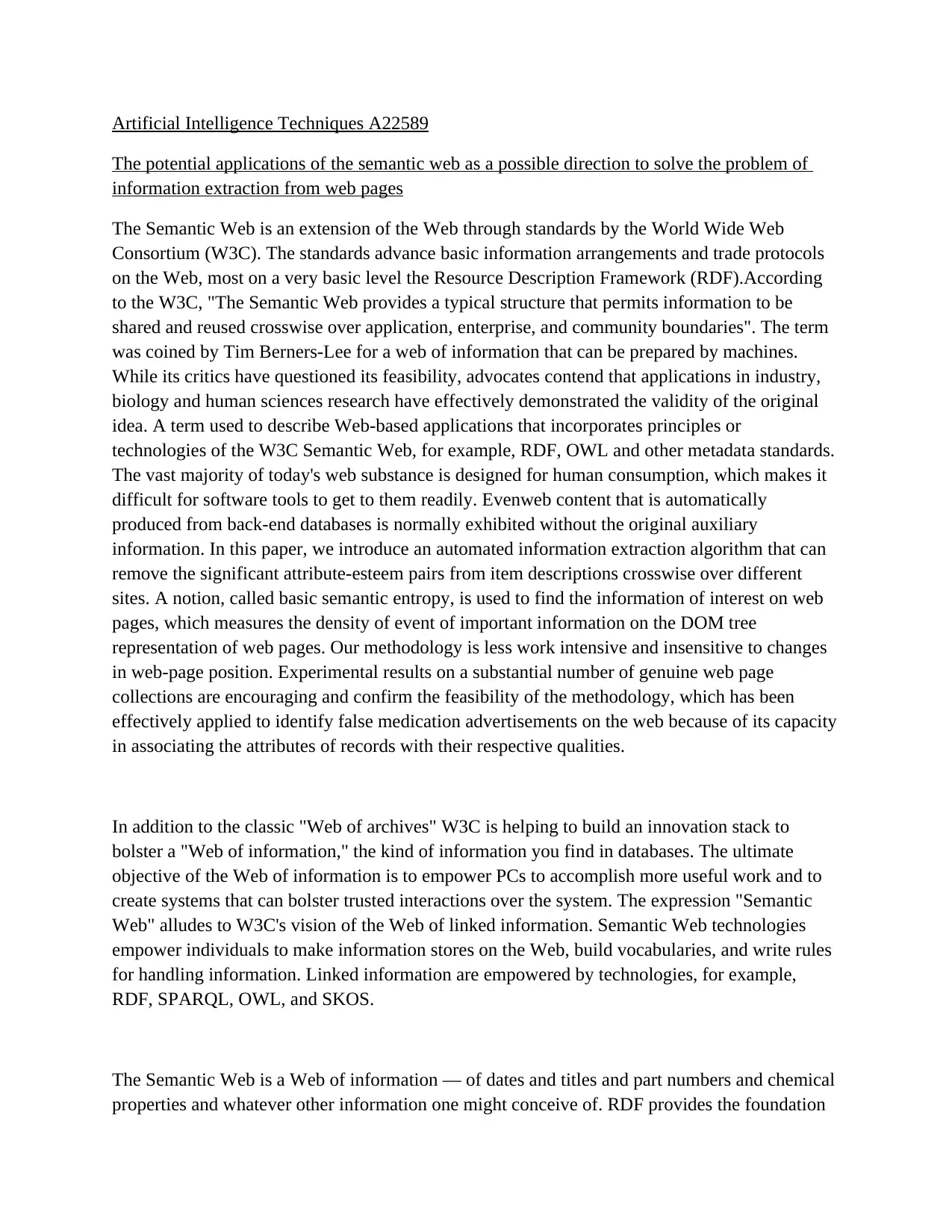
Artificial Intelligence Techniques A22589
The potential applications of the semantic web as a possible direction to solve the problem of
information extraction from web pages
The Semantic Web is an extension of the Web through standards by the World Wide Web
Consortium (W3C). The standards advance basic information arrangements and trade protocols
on the Web, most on a very basic level the Resource Description Framework (RDF).According
to the W3C, "The Semantic Web provides a typical structure that permits information to be
shared and reused crosswise over application, enterprise, and community boundaries". The term
was coined by Tim Berners-Lee for a web of information that can be prepared by machines.
While its critics have questioned its feasibility, advocates contend that applications in industry,
biology and human sciences research have effectively demonstrated the validity of the original
idea. A term used to describe Web-based applications that incorporates principles or
technologies of the W3C Semantic Web, for example, RDF, OWL and other metadata standards.
The vast majority of today's web substance is designed for human consumption, which makes it
difficult for software tools to get to them readily. Evenweb content that is automatically
produced from back-end databases is normally exhibited without the original auxiliary
information. In this paper, we introduce an automated information extraction algorithm that can
remove the significant attribute-esteem pairs from item descriptions crosswise over different
sites. A notion, called basic semantic entropy, is used to find the information of interest on web
pages, which measures the density of event of important information on the DOM tree
representation of web pages. Our methodology is less work intensive and insensitive to changes
in web-page position. Experimental results on a substantial number of genuine web page
collections are encouraging and confirm the feasibility of the methodology, which has been
effectively applied to identify false medication advertisements on the web because of its capacity
in associating the attributes of records with their respective qualities.
In addition to the classic "Web of archives" W3C is helping to build an innovation stack to
bolster a "Web of information," the kind of information you find in databases. The ultimate
objective of the Web of information is to empower PCs to accomplish more useful work and to
create systems that can bolster trusted interactions over the system. The expression "Semantic
Web" alludes to W3C's vision of the Web of linked information. Semantic Web technologies
empower individuals to make information stores on the Web, build vocabularies, and write rules
for handling information. Linked information are empowered by technologies, for example,
RDF, SPARQL, OWL, and SKOS.
The Semantic Web is a Web of information — of dates and titles and part numbers and chemical
properties and whatever other information one might conceive of. RDF provides the foundation
The potential applications of the semantic web as a possible direction to solve the problem of
information extraction from web pages
The Semantic Web is an extension of the Web through standards by the World Wide Web
Consortium (W3C). The standards advance basic information arrangements and trade protocols
on the Web, most on a very basic level the Resource Description Framework (RDF).According
to the W3C, "The Semantic Web provides a typical structure that permits information to be
shared and reused crosswise over application, enterprise, and community boundaries". The term
was coined by Tim Berners-Lee for a web of information that can be prepared by machines.
While its critics have questioned its feasibility, advocates contend that applications in industry,
biology and human sciences research have effectively demonstrated the validity of the original
idea. A term used to describe Web-based applications that incorporates principles or
technologies of the W3C Semantic Web, for example, RDF, OWL and other metadata standards.
The vast majority of today's web substance is designed for human consumption, which makes it
difficult for software tools to get to them readily. Evenweb content that is automatically
produced from back-end databases is normally exhibited without the original auxiliary
information. In this paper, we introduce an automated information extraction algorithm that can
remove the significant attribute-esteem pairs from item descriptions crosswise over different
sites. A notion, called basic semantic entropy, is used to find the information of interest on web
pages, which measures the density of event of important information on the DOM tree
representation of web pages. Our methodology is less work intensive and insensitive to changes
in web-page position. Experimental results on a substantial number of genuine web page
collections are encouraging and confirm the feasibility of the methodology, which has been
effectively applied to identify false medication advertisements on the web because of its capacity
in associating the attributes of records with their respective qualities.
In addition to the classic "Web of archives" W3C is helping to build an innovation stack to
bolster a "Web of information," the kind of information you find in databases. The ultimate
objective of the Web of information is to empower PCs to accomplish more useful work and to
create systems that can bolster trusted interactions over the system. The expression "Semantic
Web" alludes to W3C's vision of the Web of linked information. Semantic Web technologies
empower individuals to make information stores on the Web, build vocabularies, and write rules
for handling information. Linked information are empowered by technologies, for example,
RDF, SPARQL, OWL, and SKOS.
The Semantic Web is a Web of information — of dates and titles and part numbers and chemical
properties and whatever other information one might conceive of. RDF provides the foundation
Paraphrase This Document
Need a fresh take? Get an instant paraphrase of this document with our AI Paraphraser
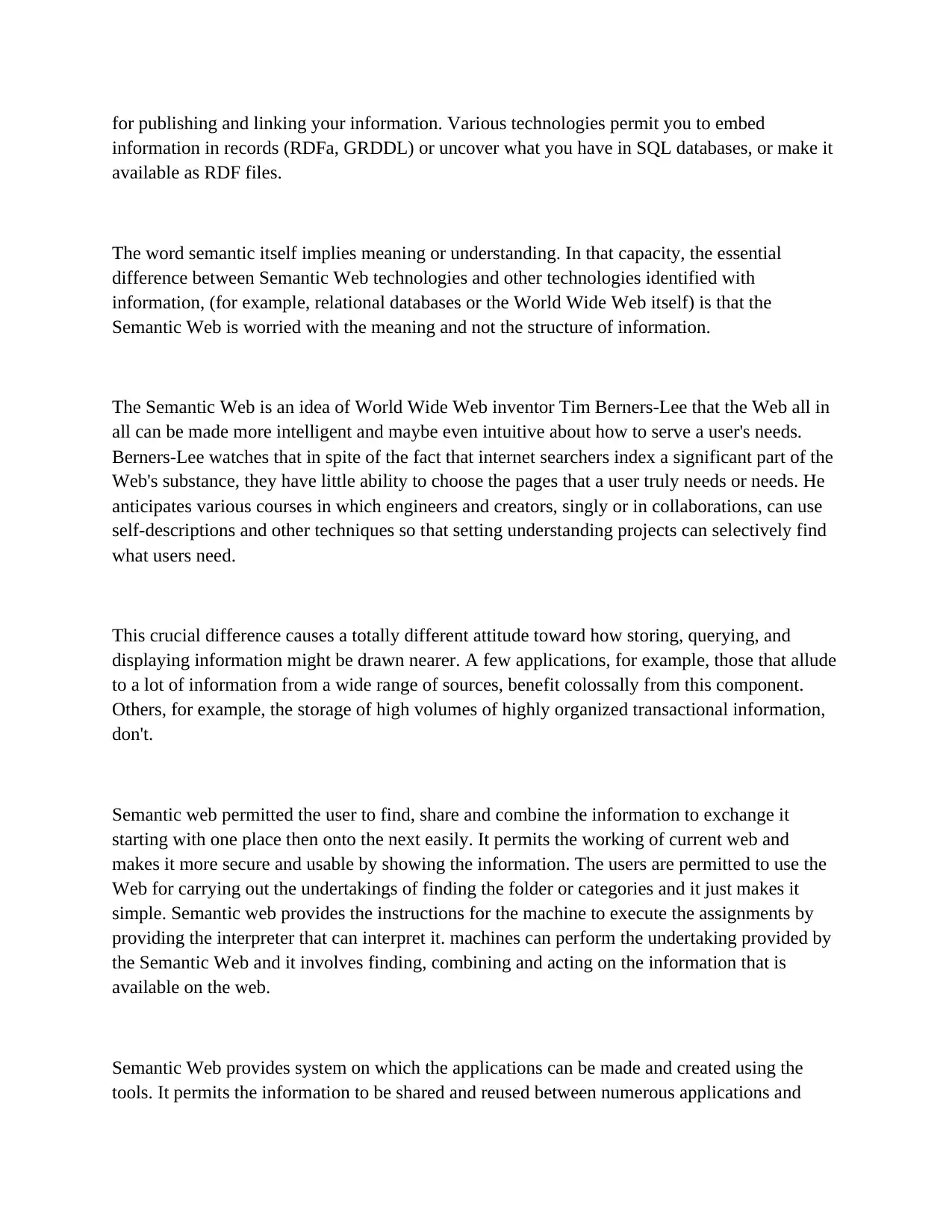
for publishing and linking your information. Various technologies permit you to embed
information in records (RDFa, GRDDL) or uncover what you have in SQL databases, or make it
available as RDF files.
The word semantic itself implies meaning or understanding. In that capacity, the essential
difference between Semantic Web technologies and other technologies identified with
information, (for example, relational databases or the World Wide Web itself) is that the
Semantic Web is worried with the meaning and not the structure of information.
The Semantic Web is an idea of World Wide Web inventor Tim Berners-Lee that the Web all in
all can be made more intelligent and maybe even intuitive about how to serve a user's needs.
Berners-Lee watches that in spite of the fact that internet searchers index a significant part of the
Web's substance, they have little ability to choose the pages that a user truly needs or needs. He
anticipates various courses in which engineers and creators, singly or in collaborations, can use
self-descriptions and other techniques so that setting understanding projects can selectively find
what users need.
This crucial difference causes a totally different attitude toward how storing, querying, and
displaying information might be drawn nearer. A few applications, for example, those that allude
to a lot of information from a wide range of sources, benefit colossally from this component.
Others, for example, the storage of high volumes of highly organized transactional information,
don't.
Semantic web permitted the user to find, share and combine the information to exchange it
starting with one place then onto the next easily. It permits the working of current web and
makes it more secure and usable by showing the information. The users are permitted to use the
Web for carrying out the undertakings of finding the folder or categories and it just makes it
simple. Semantic web provides the instructions for the machine to execute the assignments by
providing the interpreter that can interpret it. machines can perform the undertaking provided by
the Semantic Web and it involves finding, combining and acting on the information that is
available on the web.
Semantic Web provides system on which the applications can be made and created using the
tools. It permits the information to be shared and reused between numerous applications and
information in records (RDFa, GRDDL) or uncover what you have in SQL databases, or make it
available as RDF files.
The word semantic itself implies meaning or understanding. In that capacity, the essential
difference between Semantic Web technologies and other technologies identified with
information, (for example, relational databases or the World Wide Web itself) is that the
Semantic Web is worried with the meaning and not the structure of information.
The Semantic Web is an idea of World Wide Web inventor Tim Berners-Lee that the Web all in
all can be made more intelligent and maybe even intuitive about how to serve a user's needs.
Berners-Lee watches that in spite of the fact that internet searchers index a significant part of the
Web's substance, they have little ability to choose the pages that a user truly needs or needs. He
anticipates various courses in which engineers and creators, singly or in collaborations, can use
self-descriptions and other techniques so that setting understanding projects can selectively find
what users need.
This crucial difference causes a totally different attitude toward how storing, querying, and
displaying information might be drawn nearer. A few applications, for example, those that allude
to a lot of information from a wide range of sources, benefit colossally from this component.
Others, for example, the storage of high volumes of highly organized transactional information,
don't.
Semantic web permitted the user to find, share and combine the information to exchange it
starting with one place then onto the next easily. It permits the working of current web and
makes it more secure and usable by showing the information. The users are permitted to use the
Web for carrying out the undertakings of finding the folder or categories and it just makes it
simple. Semantic web provides the instructions for the machine to execute the assignments by
providing the interpreter that can interpret it. machines can perform the undertaking provided by
the Semantic Web and it involves finding, combining and acting on the information that is
available on the web.
Semantic Web provides system on which the applications can be made and created using the
tools. It permits the information to be shared and reused between numerous applications and
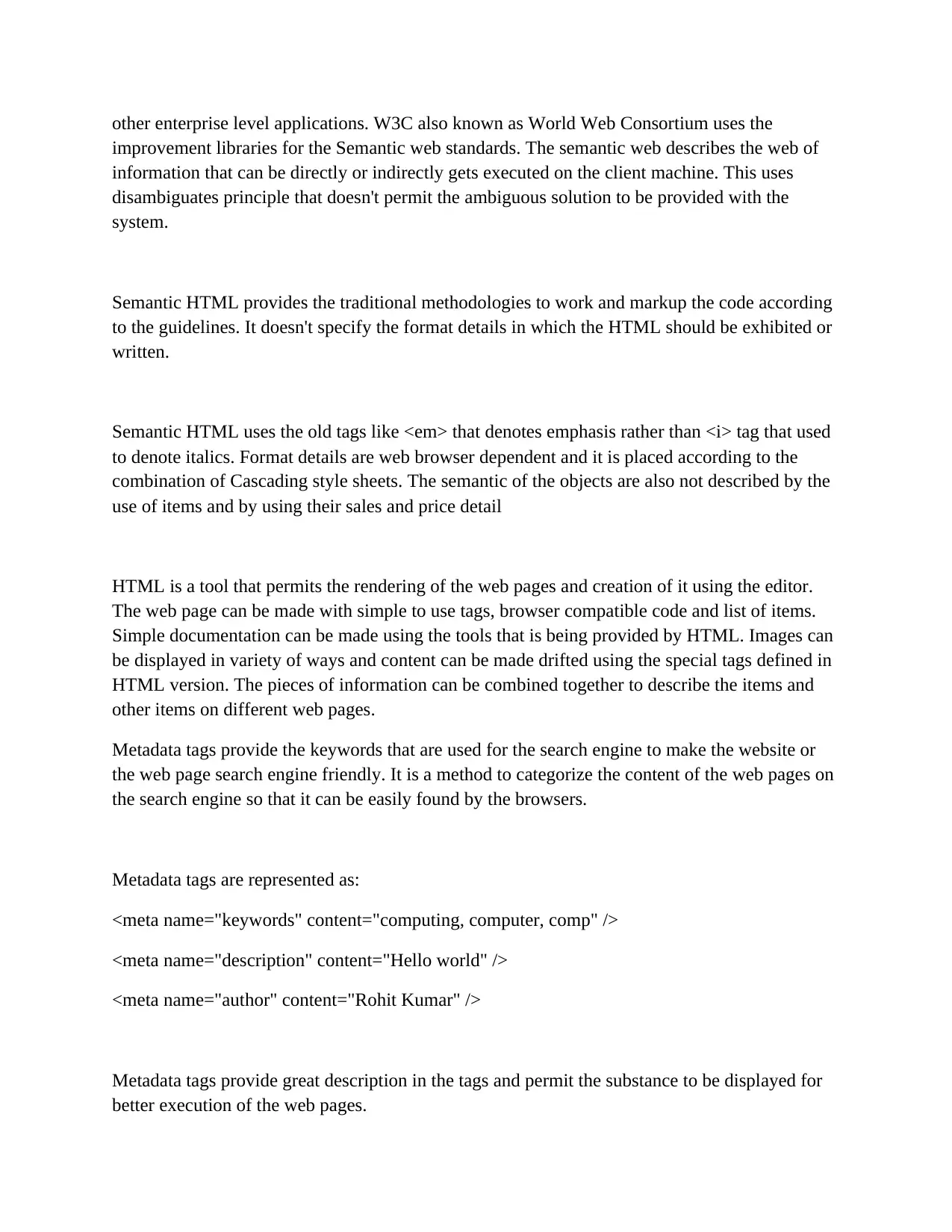
other enterprise level applications. W3C also known as World Web Consortium uses the
improvement libraries for the Semantic web standards. The semantic web describes the web of
information that can be directly or indirectly gets executed on the client machine. This uses
disambiguates principle that doesn't permit the ambiguous solution to be provided with the
system.
Semantic HTML provides the traditional methodologies to work and markup the code according
to the guidelines. It doesn't specify the format details in which the HTML should be exhibited or
written.
Semantic HTML uses the old tags like <em> that denotes emphasis rather than <i> tag that used
to denote italics. Format details are web browser dependent and it is placed according to the
combination of Cascading style sheets. The semantic of the objects are also not described by the
use of items and by using their sales and price detail
HTML is a tool that permits the rendering of the web pages and creation of it using the editor.
The web page can be made with simple to use tags, browser compatible code and list of items.
Simple documentation can be made using the tools that is being provided by HTML. Images can
be displayed in variety of ways and content can be made drifted using the special tags defined in
HTML version. The pieces of information can be combined together to describe the items and
other items on different web pages.
Metadata tags provide the keywords that are used for the search engine to make the website or
the web page search engine friendly. It is a method to categorize the content of the web pages on
the search engine so that it can be easily found by the browsers.
Metadata tags are represented as:
<meta name="keywords" content="computing, computer, comp" />
<meta name="description" content="Hello world" />
<meta name="author" content="Rohit Kumar" />
Metadata tags provide great description in the tags and permit the substance to be displayed for
better execution of the web pages.
improvement libraries for the Semantic web standards. The semantic web describes the web of
information that can be directly or indirectly gets executed on the client machine. This uses
disambiguates principle that doesn't permit the ambiguous solution to be provided with the
system.
Semantic HTML provides the traditional methodologies to work and markup the code according
to the guidelines. It doesn't specify the format details in which the HTML should be exhibited or
written.
Semantic HTML uses the old tags like <em> that denotes emphasis rather than <i> tag that used
to denote italics. Format details are web browser dependent and it is placed according to the
combination of Cascading style sheets. The semantic of the objects are also not described by the
use of items and by using their sales and price detail
HTML is a tool that permits the rendering of the web pages and creation of it using the editor.
The web page can be made with simple to use tags, browser compatible code and list of items.
Simple documentation can be made using the tools that is being provided by HTML. Images can
be displayed in variety of ways and content can be made drifted using the special tags defined in
HTML version. The pieces of information can be combined together to describe the items and
other items on different web pages.
Metadata tags provide the keywords that are used for the search engine to make the website or
the web page search engine friendly. It is a method to categorize the content of the web pages on
the search engine so that it can be easily found by the browsers.
Metadata tags are represented as:
<meta name="keywords" content="computing, computer, comp" />
<meta name="description" content="Hello world" />
<meta name="author" content="Rohit Kumar" />
Metadata tags provide great description in the tags and permit the substance to be displayed for
better execution of the web pages.
⊘ This is a preview!⊘
Do you want full access?
Subscribe today to unlock all pages.

Trusted by 1+ million students worldwide
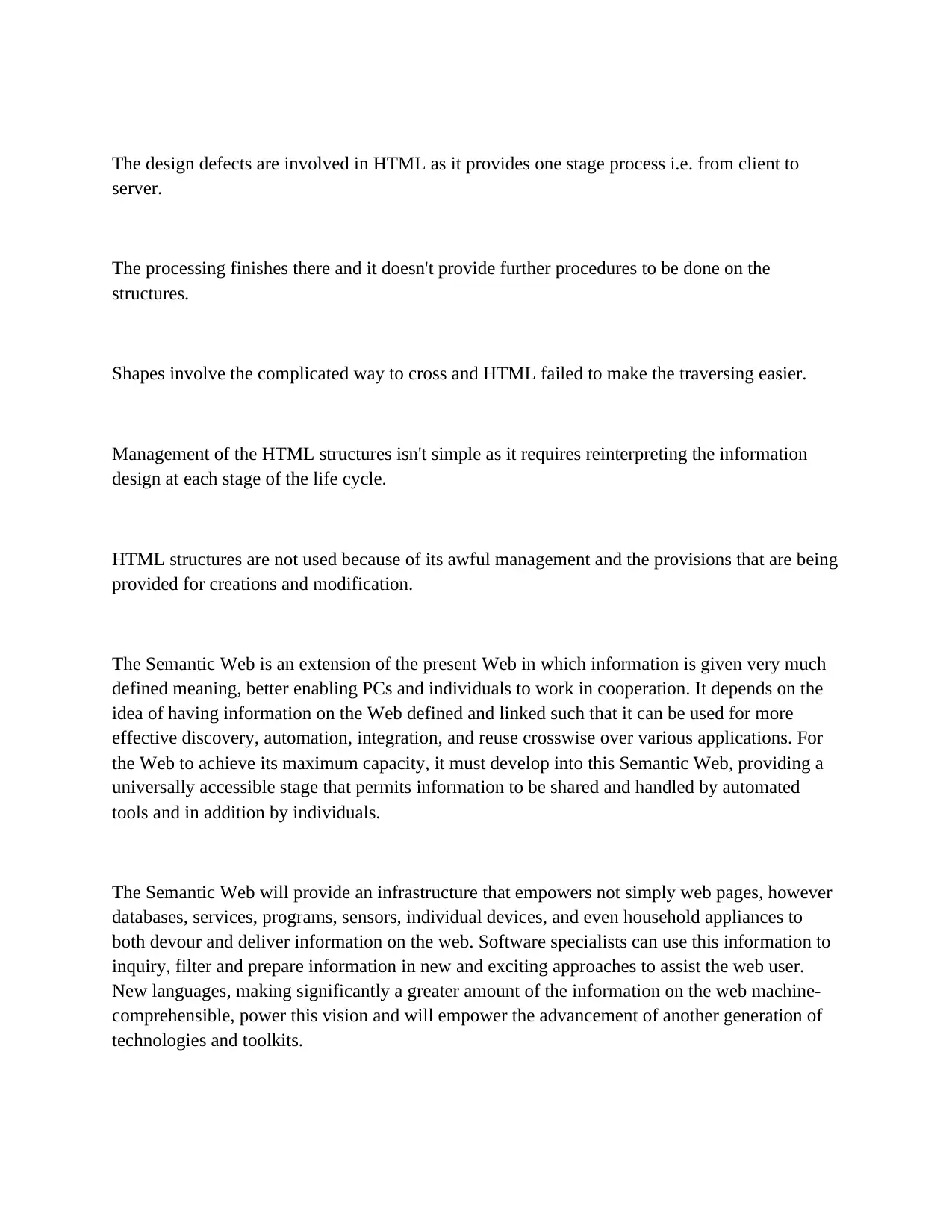
The design defects are involved in HTML as it provides one stage process i.e. from client to
server.
The processing finishes there and it doesn't provide further procedures to be done on the
structures.
Shapes involve the complicated way to cross and HTML failed to make the traversing easier.
Management of the HTML structures isn't simple as it requires reinterpreting the information
design at each stage of the life cycle.
HTML structures are not used because of its awful management and the provisions that are being
provided for creations and modification.
The Semantic Web is an extension of the present Web in which information is given very much
defined meaning, better enabling PCs and individuals to work in cooperation. It depends on the
idea of having information on the Web defined and linked such that it can be used for more
effective discovery, automation, integration, and reuse crosswise over various applications. For
the Web to achieve its maximum capacity, it must develop into this Semantic Web, providing a
universally accessible stage that permits information to be shared and handled by automated
tools and in addition by individuals.
The Semantic Web will provide an infrastructure that empowers not simply web pages, however
databases, services, programs, sensors, individual devices, and even household appliances to
both devour and deliver information on the web. Software specialists can use this information to
inquiry, filter and prepare information in new and exciting approaches to assist the web user.
New languages, making significantly a greater amount of the information on the web machine-
comprehensible, power this vision and will empower the advancement of another generation of
technologies and toolkits.
server.
The processing finishes there and it doesn't provide further procedures to be done on the
structures.
Shapes involve the complicated way to cross and HTML failed to make the traversing easier.
Management of the HTML structures isn't simple as it requires reinterpreting the information
design at each stage of the life cycle.
HTML structures are not used because of its awful management and the provisions that are being
provided for creations and modification.
The Semantic Web is an extension of the present Web in which information is given very much
defined meaning, better enabling PCs and individuals to work in cooperation. It depends on the
idea of having information on the Web defined and linked such that it can be used for more
effective discovery, automation, integration, and reuse crosswise over various applications. For
the Web to achieve its maximum capacity, it must develop into this Semantic Web, providing a
universally accessible stage that permits information to be shared and handled by automated
tools and in addition by individuals.
The Semantic Web will provide an infrastructure that empowers not simply web pages, however
databases, services, programs, sensors, individual devices, and even household appliances to
both devour and deliver information on the web. Software specialists can use this information to
inquiry, filter and prepare information in new and exciting approaches to assist the web user.
New languages, making significantly a greater amount of the information on the web machine-
comprehensible, power this vision and will empower the advancement of another generation of
technologies and toolkits.
Paraphrase This Document
Need a fresh take? Get an instant paraphrase of this document with our AI Paraphraser
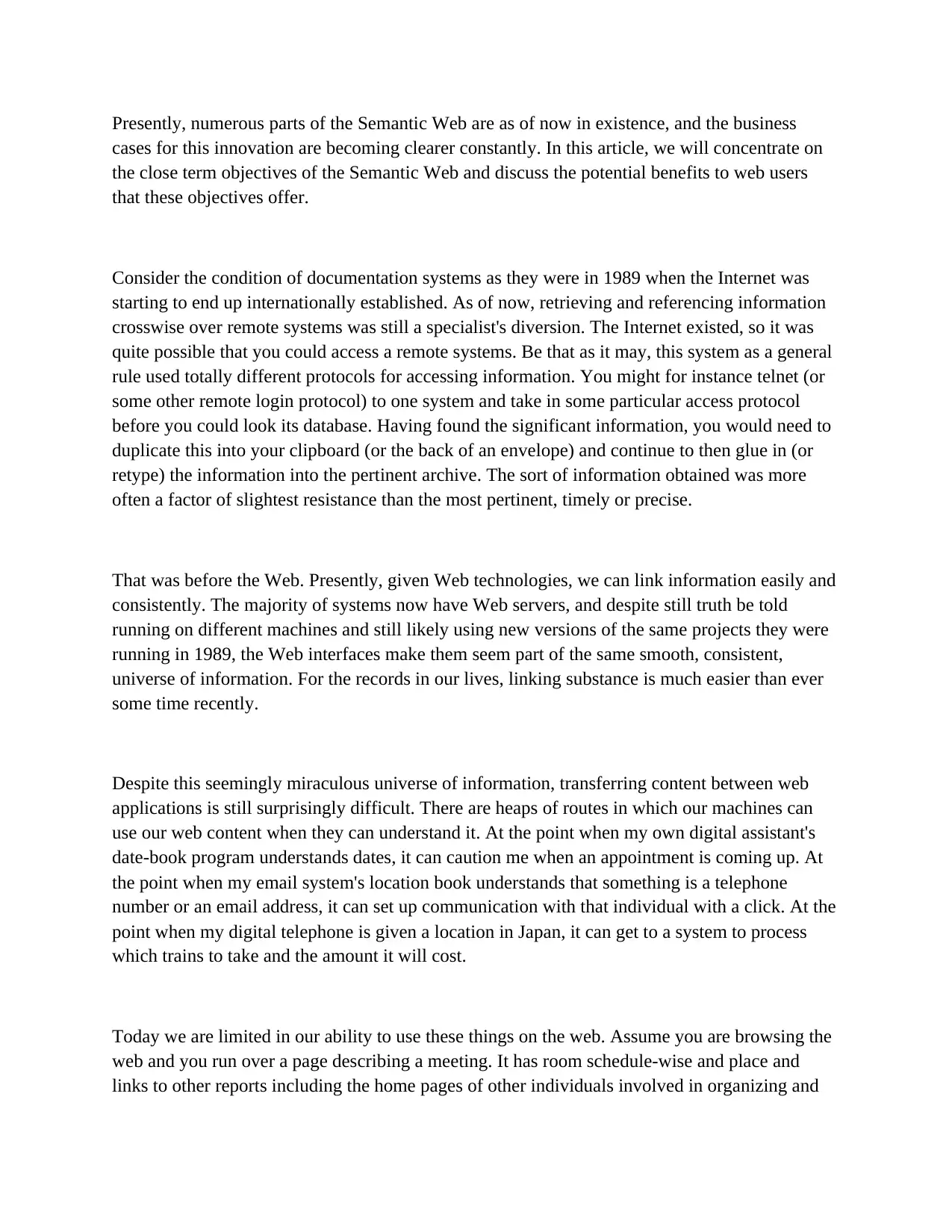
Presently, numerous parts of the Semantic Web are as of now in existence, and the business
cases for this innovation are becoming clearer constantly. In this article, we will concentrate on
the close term objectives of the Semantic Web and discuss the potential benefits to web users
that these objectives offer.
Consider the condition of documentation systems as they were in 1989 when the Internet was
starting to end up internationally established. As of now, retrieving and referencing information
crosswise over remote systems was still a specialist's diversion. The Internet existed, so it was
quite possible that you could access a remote systems. Be that as it may, this system as a general
rule used totally different protocols for accessing information. You might for instance telnet (or
some other remote login protocol) to one system and take in some particular access protocol
before you could look its database. Having found the significant information, you would need to
duplicate this into your clipboard (or the back of an envelope) and continue to then glue in (or
retype) the information into the pertinent archive. The sort of information obtained was more
often a factor of slightest resistance than the most pertinent, timely or precise.
That was before the Web. Presently, given Web technologies, we can link information easily and
consistently. The majority of systems now have Web servers, and despite still truth be told
running on different machines and still likely using new versions of the same projects they were
running in 1989, the Web interfaces make them seem part of the same smooth, consistent,
universe of information. For the records in our lives, linking substance is much easier than ever
some time recently.
Despite this seemingly miraculous universe of information, transferring content between web
applications is still surprisingly difficult. There are heaps of routes in which our machines can
use our web content when they can understand it. At the point when my own digital assistant's
date-book program understands dates, it can caution me when an appointment is coming up. At
the point when my email system's location book understands that something is a telephone
number or an email address, it can set up communication with that individual with a click. At the
point when my digital telephone is given a location in Japan, it can get to a system to process
which trains to take and the amount it will cost.
Today we are limited in our ability to use these things on the web. Assume you are browsing the
web and you run over a page describing a meeting. It has room schedule-wise and place and
links to other reports including the home pages of other individuals involved in organizing and
cases for this innovation are becoming clearer constantly. In this article, we will concentrate on
the close term objectives of the Semantic Web and discuss the potential benefits to web users
that these objectives offer.
Consider the condition of documentation systems as they were in 1989 when the Internet was
starting to end up internationally established. As of now, retrieving and referencing information
crosswise over remote systems was still a specialist's diversion. The Internet existed, so it was
quite possible that you could access a remote systems. Be that as it may, this system as a general
rule used totally different protocols for accessing information. You might for instance telnet (or
some other remote login protocol) to one system and take in some particular access protocol
before you could look its database. Having found the significant information, you would need to
duplicate this into your clipboard (or the back of an envelope) and continue to then glue in (or
retype) the information into the pertinent archive. The sort of information obtained was more
often a factor of slightest resistance than the most pertinent, timely or precise.
That was before the Web. Presently, given Web technologies, we can link information easily and
consistently. The majority of systems now have Web servers, and despite still truth be told
running on different machines and still likely using new versions of the same projects they were
running in 1989, the Web interfaces make them seem part of the same smooth, consistent,
universe of information. For the records in our lives, linking substance is much easier than ever
some time recently.
Despite this seemingly miraculous universe of information, transferring content between web
applications is still surprisingly difficult. There are heaps of routes in which our machines can
use our web content when they can understand it. At the point when my own digital assistant's
date-book program understands dates, it can caution me when an appointment is coming up. At
the point when my email system's location book understands that something is a telephone
number or an email address, it can set up communication with that individual with a click. At the
point when my digital telephone is given a location in Japan, it can get to a system to process
which trains to take and the amount it will cost.
Today we are limited in our ability to use these things on the web. Assume you are browsing the
web and you run over a page describing a meeting. It has room schedule-wise and place and
links to other reports including the home pages of other individuals involved in organizing and
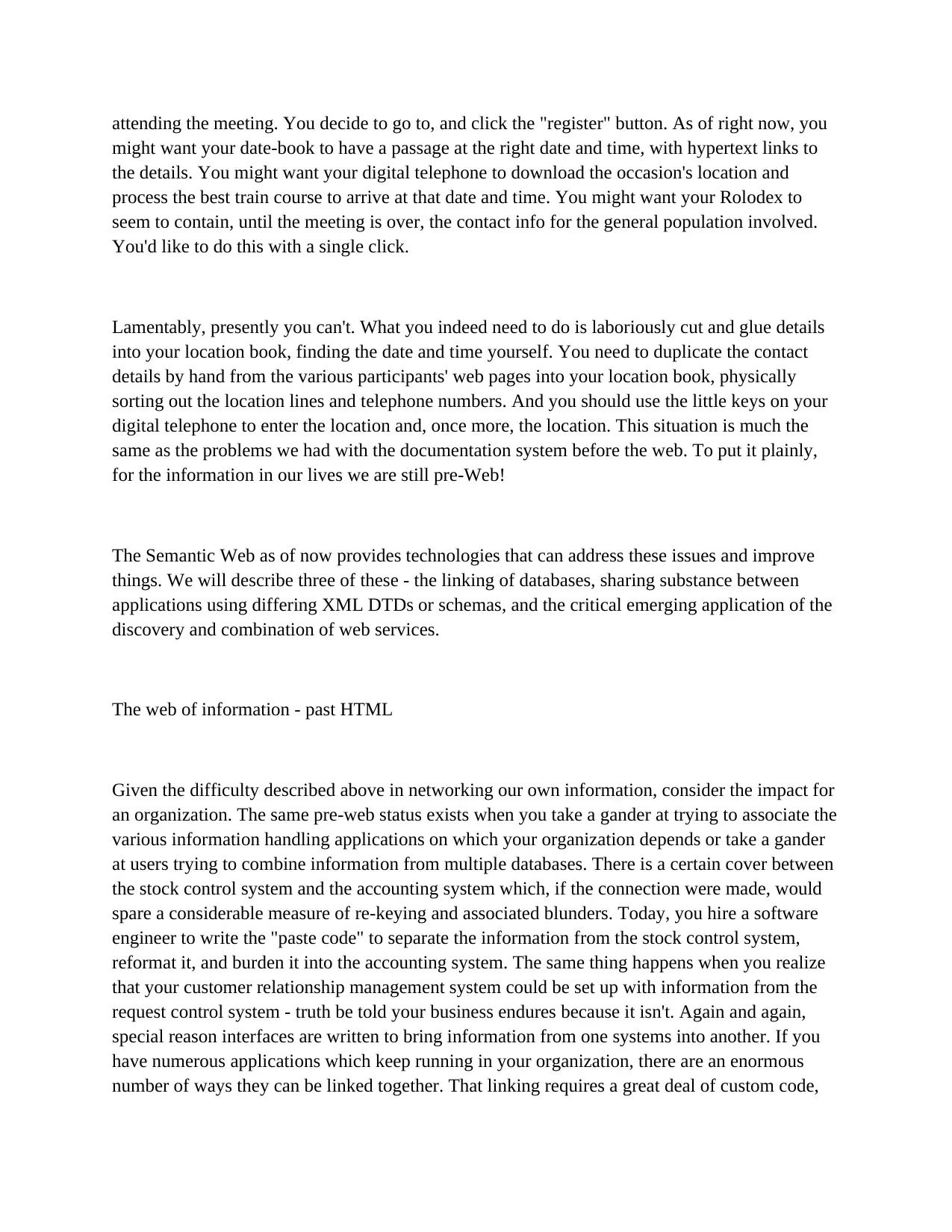
attending the meeting. You decide to go to, and click the "register" button. As of right now, you
might want your date-book to have a passage at the right date and time, with hypertext links to
the details. You might want your digital telephone to download the occasion's location and
process the best train course to arrive at that date and time. You might want your Rolodex to
seem to contain, until the meeting is over, the contact info for the general population involved.
You'd like to do this with a single click.
Lamentably, presently you can't. What you indeed need to do is laboriously cut and glue details
into your location book, finding the date and time yourself. You need to duplicate the contact
details by hand from the various participants' web pages into your location book, physically
sorting out the location lines and telephone numbers. And you should use the little keys on your
digital telephone to enter the location and, once more, the location. This situation is much the
same as the problems we had with the documentation system before the web. To put it plainly,
for the information in our lives we are still pre-Web!
The Semantic Web as of now provides technologies that can address these issues and improve
things. We will describe three of these - the linking of databases, sharing substance between
applications using differing XML DTDs or schemas, and the critical emerging application of the
discovery and combination of web services.
The web of information - past HTML
Given the difficulty described above in networking our own information, consider the impact for
an organization. The same pre-web status exists when you take a gander at trying to associate the
various information handling applications on which your organization depends or take a gander
at users trying to combine information from multiple databases. There is a certain cover between
the stock control system and the accounting system which, if the connection were made, would
spare a considerable measure of re-keying and associated blunders. Today, you hire a software
engineer to write the "paste code" to separate the information from the stock control system,
reformat it, and burden it into the accounting system. The same thing happens when you realize
that your customer relationship management system could be set up with information from the
request control system - truth be told your business endures because it isn't. Again and again,
special reason interfaces are written to bring information from one systems into another. If you
have numerous applications which keep running in your organization, there are an enormous
number of ways they can be linked together. That linking requires a great deal of custom code,
might want your date-book to have a passage at the right date and time, with hypertext links to
the details. You might want your digital telephone to download the occasion's location and
process the best train course to arrive at that date and time. You might want your Rolodex to
seem to contain, until the meeting is over, the contact info for the general population involved.
You'd like to do this with a single click.
Lamentably, presently you can't. What you indeed need to do is laboriously cut and glue details
into your location book, finding the date and time yourself. You need to duplicate the contact
details by hand from the various participants' web pages into your location book, physically
sorting out the location lines and telephone numbers. And you should use the little keys on your
digital telephone to enter the location and, once more, the location. This situation is much the
same as the problems we had with the documentation system before the web. To put it plainly,
for the information in our lives we are still pre-Web!
The Semantic Web as of now provides technologies that can address these issues and improve
things. We will describe three of these - the linking of databases, sharing substance between
applications using differing XML DTDs or schemas, and the critical emerging application of the
discovery and combination of web services.
The web of information - past HTML
Given the difficulty described above in networking our own information, consider the impact for
an organization. The same pre-web status exists when you take a gander at trying to associate the
various information handling applications on which your organization depends or take a gander
at users trying to combine information from multiple databases. There is a certain cover between
the stock control system and the accounting system which, if the connection were made, would
spare a considerable measure of re-keying and associated blunders. Today, you hire a software
engineer to write the "paste code" to separate the information from the stock control system,
reformat it, and burden it into the accounting system. The same thing happens when you realize
that your customer relationship management system could be set up with information from the
request control system - truth be told your business endures because it isn't. Again and again,
special reason interfaces are written to bring information from one systems into another. If you
have numerous applications which keep running in your organization, there are an enormous
number of ways they can be linked together. That linking requires a great deal of custom code,
⊘ This is a preview!⊘
Do you want full access?
Subscribe today to unlock all pages.

Trusted by 1+ million students worldwide
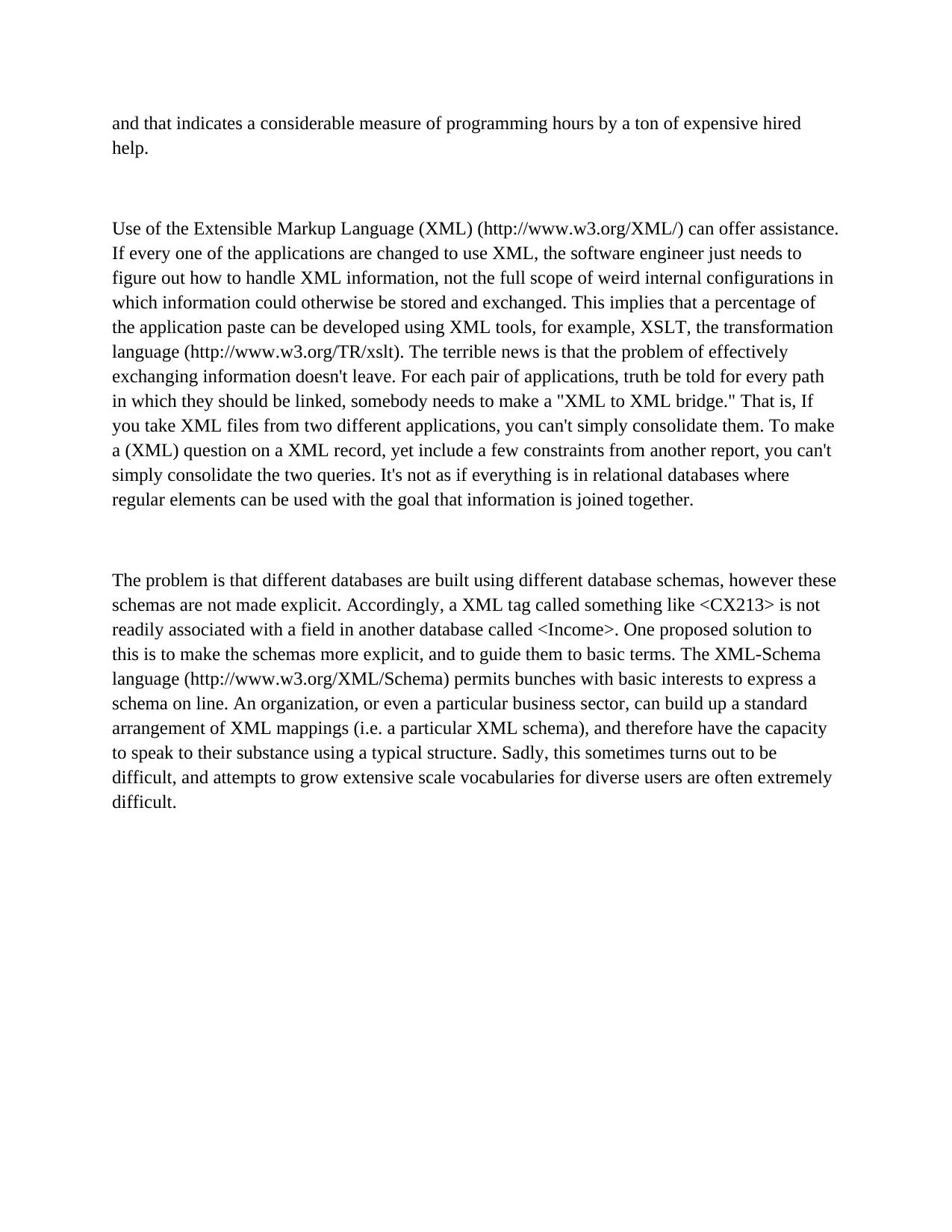
and that indicates a considerable measure of programming hours by a ton of expensive hired
help.
Use of the Extensible Markup Language (XML) (http://www.w3.org/XML/) can offer assistance.
If every one of the applications are changed to use XML, the software engineer just needs to
figure out how to handle XML information, not the full scope of weird internal configurations in
which information could otherwise be stored and exchanged. This implies that a percentage of
the application paste can be developed using XML tools, for example, XSLT, the transformation
language (http://www.w3.org/TR/xslt). The terrible news is that the problem of effectively
exchanging information doesn't leave. For each pair of applications, truth be told for every path
in which they should be linked, somebody needs to make a "XML to XML bridge." That is, If
you take XML files from two different applications, you can't simply consolidate them. To make
a (XML) question on a XML record, yet include a few constraints from another report, you can't
simply consolidate the two queries. It's not as if everything is in relational databases where
regular elements can be used with the goal that information is joined together.
The problem is that different databases are built using different database schemas, however these
schemas are not made explicit. Accordingly, a XML tag called something like <CX213> is not
readily associated with a field in another database called <Income>. One proposed solution to
this is to make the schemas more explicit, and to guide them to basic terms. The XML-Schema
language (http://www.w3.org/XML/Schema) permits bunches with basic interests to express a
schema on line. An organization, or even a particular business sector, can build up a standard
arrangement of XML mappings (i.e. a particular XML schema), and therefore have the capacity
to speak to their substance using a typical structure. Sadly, this sometimes turns out to be
difficult, and attempts to grow extensive scale vocabularies for diverse users are often extremely
difficult.
help.
Use of the Extensible Markup Language (XML) (http://www.w3.org/XML/) can offer assistance.
If every one of the applications are changed to use XML, the software engineer just needs to
figure out how to handle XML information, not the full scope of weird internal configurations in
which information could otherwise be stored and exchanged. This implies that a percentage of
the application paste can be developed using XML tools, for example, XSLT, the transformation
language (http://www.w3.org/TR/xslt). The terrible news is that the problem of effectively
exchanging information doesn't leave. For each pair of applications, truth be told for every path
in which they should be linked, somebody needs to make a "XML to XML bridge." That is, If
you take XML files from two different applications, you can't simply consolidate them. To make
a (XML) question on a XML record, yet include a few constraints from another report, you can't
simply consolidate the two queries. It's not as if everything is in relational databases where
regular elements can be used with the goal that information is joined together.
The problem is that different databases are built using different database schemas, however these
schemas are not made explicit. Accordingly, a XML tag called something like <CX213> is not
readily associated with a field in another database called <Income>. One proposed solution to
this is to make the schemas more explicit, and to guide them to basic terms. The XML-Schema
language (http://www.w3.org/XML/Schema) permits bunches with basic interests to express a
schema on line. An organization, or even a particular business sector, can build up a standard
arrangement of XML mappings (i.e. a particular XML schema), and therefore have the capacity
to speak to their substance using a typical structure. Sadly, this sometimes turns out to be
difficult, and attempts to grow extensive scale vocabularies for diverse users are often extremely
difficult.
Paraphrase This Document
Need a fresh take? Get an instant paraphrase of this document with our AI Paraphraser
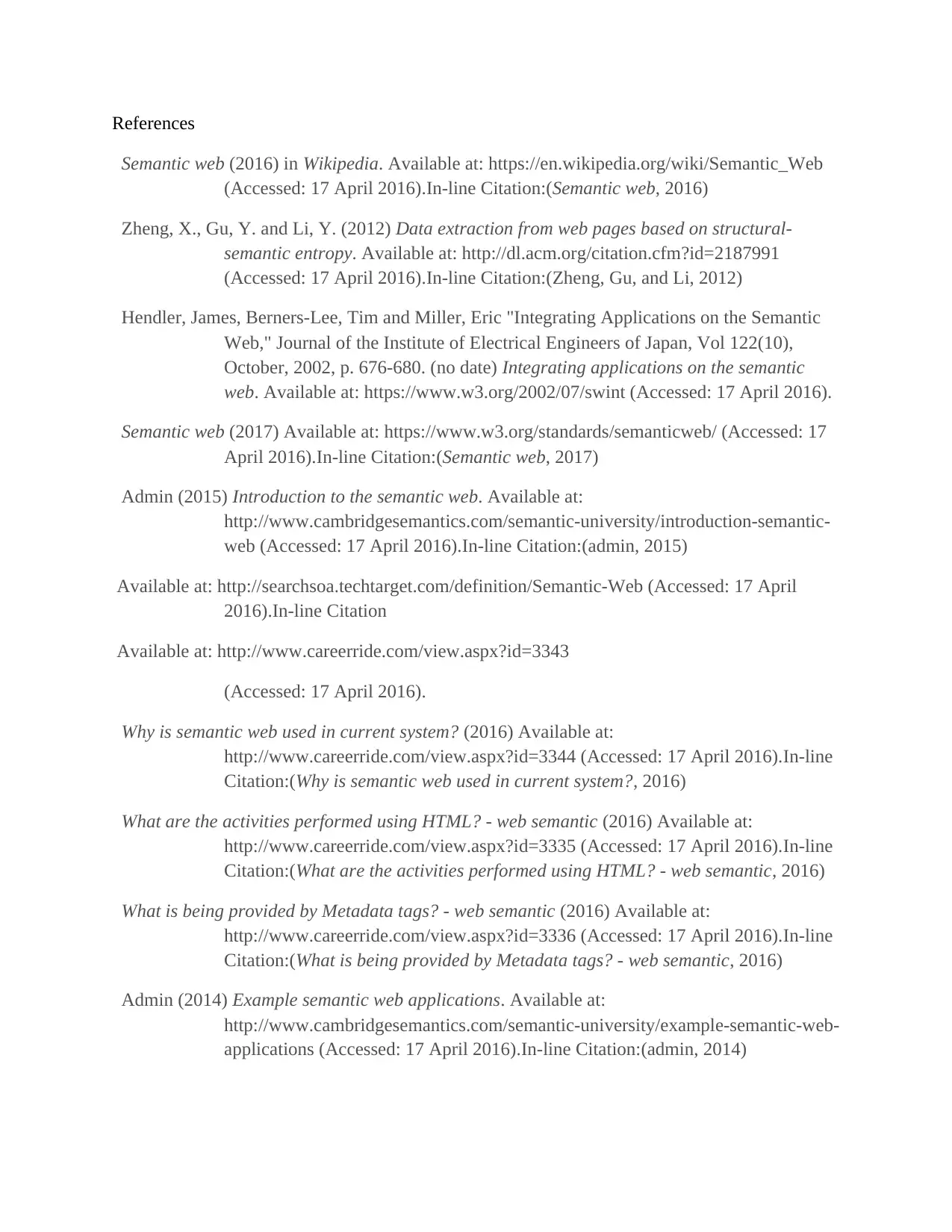
References
Semantic web (2016) in Wikipedia. Available at: https://en.wikipedia.org/wiki/Semantic_Web
(Accessed: 17 April 2016).In-line Citation:(Semantic web, 2016)
Zheng, X., Gu, Y. and Li, Y. (2012) Data extraction from web pages based on structural-
semantic entropy. Available at: http://dl.acm.org/citation.cfm?id=2187991
(Accessed: 17 April 2016).In-line Citation:(Zheng, Gu, and Li, 2012)
Hendler, James, Berners-Lee, Tim and Miller, Eric "Integrating Applications on the Semantic
Web," Journal of the Institute of Electrical Engineers of Japan, Vol 122(10),
October, 2002, p. 676-680. (no date) Integrating applications on the semantic
web. Available at: https://www.w3.org/2002/07/swint (Accessed: 17 April 2016).
Semantic web (2017) Available at: https://www.w3.org/standards/semanticweb/ (Accessed: 17
April 2016).In-line Citation:(Semantic web, 2017)
Admin (2015) Introduction to the semantic web. Available at:
http://www.cambridgesemantics.com/semantic-university/introduction-semantic-
web (Accessed: 17 April 2016).In-line Citation:(admin, 2015)
Available at: http://searchsoa.techtarget.com/definition/Semantic-Web (Accessed: 17 April
2016).In-line Citation
Available at: http://www.careerride.com/view.aspx?id=3343
(Accessed: 17 April 2016).
Why is semantic web used in current system? (2016) Available at:
http://www.careerride.com/view.aspx?id=3344 (Accessed: 17 April 2016).In-line
Citation:(Why is semantic web used in current system?, 2016)
What are the activities performed using HTML? - web semantic (2016) Available at:
http://www.careerride.com/view.aspx?id=3335 (Accessed: 17 April 2016).In-line
Citation:(What are the activities performed using HTML? - web semantic, 2016)
What is being provided by Metadata tags? - web semantic (2016) Available at:
http://www.careerride.com/view.aspx?id=3336 (Accessed: 17 April 2016).In-line
Citation:(What is being provided by Metadata tags? - web semantic, 2016)
Admin (2014) Example semantic web applications. Available at:
http://www.cambridgesemantics.com/semantic-university/example-semantic-web-
applications (Accessed: 17 April 2016).In-line Citation:(admin, 2014)
Semantic web (2016) in Wikipedia. Available at: https://en.wikipedia.org/wiki/Semantic_Web
(Accessed: 17 April 2016).In-line Citation:(Semantic web, 2016)
Zheng, X., Gu, Y. and Li, Y. (2012) Data extraction from web pages based on structural-
semantic entropy. Available at: http://dl.acm.org/citation.cfm?id=2187991
(Accessed: 17 April 2016).In-line Citation:(Zheng, Gu, and Li, 2012)
Hendler, James, Berners-Lee, Tim and Miller, Eric "Integrating Applications on the Semantic
Web," Journal of the Institute of Electrical Engineers of Japan, Vol 122(10),
October, 2002, p. 676-680. (no date) Integrating applications on the semantic
web. Available at: https://www.w3.org/2002/07/swint (Accessed: 17 April 2016).
Semantic web (2017) Available at: https://www.w3.org/standards/semanticweb/ (Accessed: 17
April 2016).In-line Citation:(Semantic web, 2017)
Admin (2015) Introduction to the semantic web. Available at:
http://www.cambridgesemantics.com/semantic-university/introduction-semantic-
web (Accessed: 17 April 2016).In-line Citation:(admin, 2015)
Available at: http://searchsoa.techtarget.com/definition/Semantic-Web (Accessed: 17 April
2016).In-line Citation
Available at: http://www.careerride.com/view.aspx?id=3343
(Accessed: 17 April 2016).
Why is semantic web used in current system? (2016) Available at:
http://www.careerride.com/view.aspx?id=3344 (Accessed: 17 April 2016).In-line
Citation:(Why is semantic web used in current system?, 2016)
What are the activities performed using HTML? - web semantic (2016) Available at:
http://www.careerride.com/view.aspx?id=3335 (Accessed: 17 April 2016).In-line
Citation:(What are the activities performed using HTML? - web semantic, 2016)
What is being provided by Metadata tags? - web semantic (2016) Available at:
http://www.careerride.com/view.aspx?id=3336 (Accessed: 17 April 2016).In-line
Citation:(What is being provided by Metadata tags? - web semantic, 2016)
Admin (2014) Example semantic web applications. Available at:
http://www.cambridgesemantics.com/semantic-university/example-semantic-web-
applications (Accessed: 17 April 2016).In-line Citation:(admin, 2014)

Admin (no date) What is semantic web application? Webopedia definition. Available at:
http://www.webopedia.com/TERM/S/Semantic_Web_application.html
(Accessed: 17 April 2016).
http://www.webopedia.com/TERM/S/Semantic_Web_application.html
(Accessed: 17 April 2016).
⊘ This is a preview!⊘
Do you want full access?
Subscribe today to unlock all pages.

Trusted by 1+ million students worldwide

1 out of 10
Your All-in-One AI-Powered Toolkit for Academic Success.
+13062052269
info@desklib.com
Available 24*7 on WhatsApp / Email
![[object Object]](/_next/static/media/star-bottom.7253800d.svg)
Unlock your academic potential
Copyright © 2020–2025 A2Z Services. All Rights Reserved. Developed and managed by ZUCOL.

